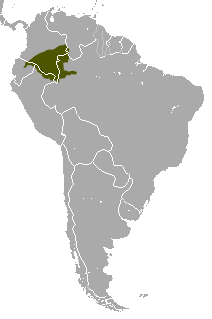Brown woolly monkey
| Brown woolly monkey[1] | |
|---|---|
.jpg) | |
| Scientific classification | |
| Kingdom: | Animalia |
| Phylum: | Chordata |
| Class: | Mammalia |
| Order: | Primates |
| Family: | Atelidae |
| Genus: | Lagothrix |
| Species: | L. lagothricha |
| Binomial name | |
| Lagothrix lagothricha (Humboldt, 1812) | |
 | |
| Brown woolly monkey range | |

The brown woolly monkey, common woolly monkey, or Humboldt's woolly monkey (Lagothrix lagothricha) is a woolly monkey from Colombia, Ecuador, Peru and Brazil. It lives in groups of two to 70 individuals, usually splitting the group into smaller subgroups when active.
Many published sources use the binomial L. lagothricha, since Fooden[3] adopted this spelling when he revised the genus. Von Humboldt used both spellings in his original description. The International Zoological Code permits a first reviser to choose an orthodox spelling.
Description
Brown woolly monkeys are large compared to most other tree-dwelling primates, with a head-body length of 40-60cm, a tail length of 55-75cm, and a weight of 5.5-10.8kg. Contrary to their name, they may also be a shade of grey or black as well as brown, and are darker on the head and underparts. The face is naked of any fur and is typically black. Most male woolly monkeys are larger than the females, also having larger canines. Brown woolly monkeys are also diurnal.[4]
Diet
Like all species of woolly monkey, brown woolly monkeys are omnivorous, but mainly frugivorous.[5] Their diet consist mainly of fruits containing 1 or 2 large seeds and fruits that are lower in fat and higher in sugar and water.[6]While they prefer certain fruits, such as fruits from the Fabaceae (Legume), Moraceae (fig), Convolvulaceae, and Sapotaceae families, which represents roughly 50% of consumption time;[7]fruit abundance and production influence their diet more than preference.[8] As such, during periods of scarcity, fruit consumption tends to decrease and leaf and insect consumption increases. Females with dependents tend to eat more leaves, most likely because the leaves contain more protein, helping the female produce more milk;[7]while juvenile woolly monkeys are shown to eat more arthropods then other members of the group.[6]
Foraging Behavior
The brown woolly monkey displays a generalist and opportunistic foraging behavior,[8] spending a large amount of time eating and moving in the pursuit of food, covering roughly 2 km per day.[6]They tend to prefer fruit species that exhibit a clumped fruit distribution, and fruits produced by large trees because they tend to produce a larger crop size and reduce the energy spent traveling between fruit patches.[8]Females with offspring were observed to be more efficient foragers than juveniles and adult males. Inter-group competition during feeding times causes the juveniles to be displaced by the adult males, and females with offspring resulting in an increase in feeding on arthropods and leaves.[6]
Habitat and Groups
The brown woolly monkey is present in the upper Amazon basin in South America, ranging from the Rio Tapajos in Brazil, to eastern Peru, Ecuador and Colombia. They also used to be found in Bolivia, however it is likely they have been extirpated by hunters.[4] They are found in the rainforest, usually in the canopy of the tallest trees, though they may also be found at shrub layer.[9] In certain seasons it is also common for groups to enter flooded forests, due to a higher concentration of berries.
References
- ↑ Groves, C.P. (2005). Wilson, D.E.; Reeder, D.M., eds. Mammal Species of the World: A Taxonomic and Geographic Reference (3rd ed.). Baltimore: Johns Hopkins University Press. p. 152. ISBN 0-801-88221-4. OCLC 62265494.
- ↑ Palacios, E.; Boubli, J.-P.; Stevenson, P.; Di Fiore, A. & de la Torre, S. (2008). "Lagothrix lagotricha". IUCN Red List of Threatened Species. Version 2011.2. International Union for Conservation of Nature. Retrieved 19 January 2012.
- ↑ Fooden, J. 1963. A revision of the woolly monkey (genus Lagothrix) Journal of Mammalogy 44(2): 213-247
- 1 2 "Common woolly monkey videos, photos and facts - Lagothrix lagotricha". ARKive. Retrieved 2017-02-21.
- ↑ "Primate Factsheets: Woolly monkey (Lagothrix) Taxonomy, Morphology, & Ecology". pin.primate.wisc.edu. Retrieved 2017-02-21.
- 1 2 3 4 Ange-van Heugten, Timmer, Jansen, Verstegen, K., S., W.L., M.W. (2008). "Nutritional and health status of woolly monkeys.". International Journal of Primatology. 29: 183–194.
- 1 2 Gonzalez, Clavijo, Betancur, & Stevenson, M., L., J., P.R (2016). "Fruits eaten by woolly monkeys (lagothrix lagothricha) at local and regional scales.". Primates. 57: 241–251.
- 1 2 3 Stevenson, P (2004). "Fruit choice by woolly monkeys in Tinigua National Park, Colombia.". International Journal of Primatology. 25: 367–381.
- ↑ "BBC Nature - Common woolly monkey videos, news and facts". Retrieved 2017-02-21.
| Wikispecies has information related to: Brown Woolly Monkey |
